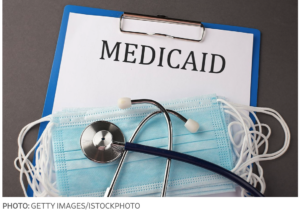
Medicaid keeps on growing like kudzu vine in a forest. Kudzu grows like a wildfire out of control and the Biden government has no interest in stopping it. They actually want it to take over everything.
This process began with the Affordable Care Act of 2010, better known as ObamaCare, which the Obama Administration pushed through Congress without a single Republican vote. Medicaid eligibility was originally defined by the federal government as 133% of the Federal Poverty Level (FPL) for pregnant women and children six years and under, 100% of FPL for children seven to eighteen, 75% of FPL for the elderly and disabled and 25% of FPL for working parents. Childless adults were ineligible. Individual states could increase these levels but could not decrease them.
ObamaCare changed all that by establishing one federal definition of eligibility at 133% of FPL. It also enticed states to increase their Medicaid rolls by offering to increase the federal subsidy from a then current average of 57% of the costs to 100% of the costs for “newly eligible” people in 2014 for three years. Thereafter the subsidies would gradually decline to 90% in 2020, but none beyond that. Many states were sucked in by this incentive only to have buyer’s remorse when the rolls of their Medicaid population ballooned past expectations and they were left with huge debts in their state’s budgets. But the federal government was only too delighted to have more people on the rolls of Medicaid.
Then the Covid pandemic hit in 2020. This gave the new Biden Administration just the excuse they needed in 2021 to expand the rolls of Medicaid further. They extended the temporary expanded eligibility guidelines of the Trump Administration well beyond the pandemic crisis to allow millions of Americans to enroll in Medicaid who did not meet the economic eligibility guidelines.
Fast forward to today and now we see the Biden, or should I say Harris, Administration going further in their quest to expand Medicaid. Here is how the Wall Street Journal editorial board described it: “Kamala Harris this week praised North Carolina’s new plan to wipe out medical debt. What the Vice President didn’t say is that the Biden Administration is making taxpayers in the rest of America pay for it. Behold how the Administration is turning Medicaid into an entitlement for progressive policies far beyond healthcare for the poor.”
The Centers for Medicare and Medicaid Services last week approved North Carolina Democratic Gov. Roy Cooper’s plan to increase federal Medicaid reimbursements for hospitals that agree to forgive medical debt and discount future bills for low- and middle-income patients. Urging other states to follow, Ms. Harris promised to continue “to relieve the burden of medical debt.”
This could be an expensive proposition. Americans owe more than $220 billion in medical debt, though perhaps Ms. Harris considers it a pittance relative to the more than $800 billion in student debt the Administration has written down. Enter Mr. Cooper, who is dangling more Medicaid money for hospitals that waive debt accrued over the last decade by patients earning less than 350% of the poverty line—$109,200 for a family of four—or whose unpaid bills exceed 5% of their annual income. Hospitals will also have to provide large discounts for patients earning less than 300% of the poverty line.
Larger federal Medicaid payments would exceed the amount of potential debt relief. But this may still be a Faustian bargain for hospitals since debt relief could cause patients to skip out on future bills. Reducing patient payments for emergency visits could also spur more to go without insurance, resulting in more uncompensated care.
Why is this government so eager to enroll more Americans in Medicaid?
This is all about expanding the welfare state to make more Americans dependent on the government. It is one more step toward socialized medicine, the complete government control of your healthcare. Don’t be fooled! When they are in complete control of your healthcare, they are in complete control of who gets treatment and who does not.


